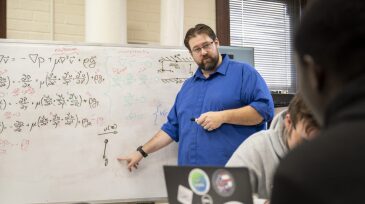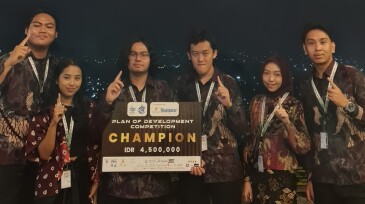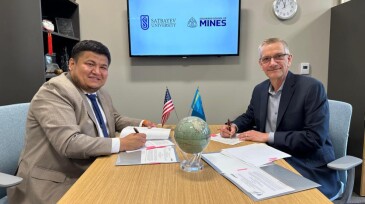Students/Education
EZOps will integrate its Mobile Oilfield Management platform into the college’s energy technology program, giving students hands-on experience with digital tools used in modern oilfield operations.
The software will enhance education and research across energy, geothermal, mining, and geotechnical engineering by giving students and faculty hands-on access to industry-standard tools used worldwide.
The event celebrated and united past and present members for learning, recognition, and a hands-on engineering competition that reinforced the chapter’s commitment to technical excellence and innovation.
-
Founding dean of Missouri S&T’s Kummer College, James D. Sterling, sat down with Joshua Schlegel, associate professor and associate chair of nuclear engineering and radiation science, to discuss why nuclear power is making a comeback and what its resurgence means for the future of energy.
-
The free, 1-day symposium will bring together graduate students, faculty, and industry leaders dedicated to advancing research, career growth, and energy innovation.
-
Emuobosa Patience Ojoboh, SPE, shares how unexpected academic challenges changed her career path and how, throughout it all, SPE served as her anchor through uncertainty.
-
Three Namibian engineering graduates have been awarded fully funded scholarships worth more than $40,000 to attend a specialized ROV pilot technician training program at the Netherlands Maritime University College in Malaysia. After completion of the training, Subsea7 will provide the graduates with on-the-job training, integrate them into its global offshore workforc…
-
UT-Austin's Matthew Balhoff, SPE, shares his advice to students and young professionals in the industry to help maximize their academic experience and early careers.
-
The SPE Patagonia Section has released a new book for all ages that features 22 stories which share stories of career beginnings, life on or near oil wells, fieldwork in the jungle, and life experiences that animate the energy industry.
-
Aman Srivastava, SPE, recently spoke with students—from elementary school to university—about the oil industry and his work in the field. What began as outreach turned into a moment of reflection on his own career. Here's what he learned.
-
Students and young professionals gathered in late May for the 2025 Latin America and the Caribbean Student Symposium for 2 days of programs including the PetroBowl regional qualifiers, student sessions, roundtable discussions with companies, and more.
-
The competition tasked participants with formulating a detailed oil and gas field development plan.
-
The campus will offer four core bachelor’s degree programs in mining, geology and geological exploration, geophysical engineering, and petroleum engineering.













